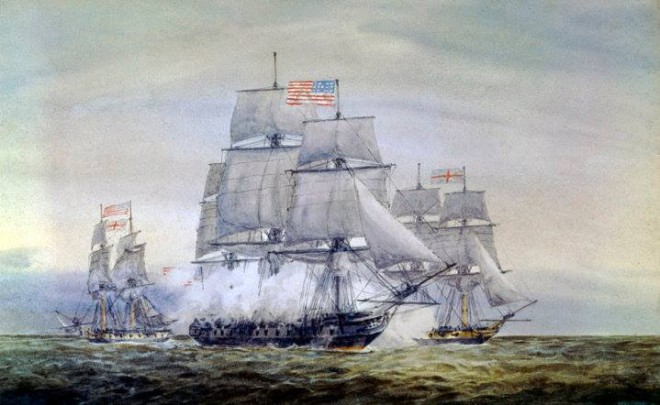
Per our National Constitution, September 13th is designated “Commodore Barry Day,” a national holiday of the Order. If you are not aware of who Commodore Barry is, you are not alone, for sadly, you are in the company of the majority of Americans. This speaks to the importance of the day and a significance of which extends far beyond the man himself.
When one looks at the 1801 portrait of Barry by Gilbert Stuart, one may get a false impression of Barry; the painting shows an old man in declining health (Barry would die two years later) after a lifetime spent battling the sea and his adopted Nation’s enemies. At the start of the American Revolution, a quarter of a century later, one would have an entirely different impression. From surviving uniforms, we know that the then 30-year-old Barry was barrel-chested and at 6′ 4″ a giant in an age when the average man stood only 5′ 5″. Born in Ireland, the son of a poor Catholic tenant farmer who had been dispossessed of his holdings during the penal laws, Barry had gone to sea at an early age as a cabin boy and was now the most sought-after Ship’s Captain in Philadelphia. On one of his voyages, Barry set the 18th-century record for the fastest single day of sail.
Yet, when the American colonies decided to strike for independence, Barry immediately offered his services to his adopted home, giving up “the finest ship and the first employ in America.” To list just a few of the highlights of Barry’s service:

- Barry was the first to capture a British warship on the high seas
- Barry captured the most ships (prizes) of any captain during the Revolution.
- During the darkest days of the Revolution, despite American defeat seeming imminent, Barry refused a bribe of £10,000 (equivalent to over a million and a half dollars today) and a commission in the Royal Navy
- When deprived of a ship when the capture of Philadelphia seemed imminent, Barry formed a regiment of sailors and marines and fought at the battles of Trenton and Princeton
- In a single engagement, Barry simultaneously fought and captured two British warships after himself being severely wounded
- Barry fought the last naval action and fired the last shot of the American Revolution.
- When the American Revolution ended, Barry and his ship, the “Alliance” was the only ship in the Continental Navy.
For this alone, Commodore John Barry should be better remembered, yet this was not the end of his service. While his fellow Captain John Paul Jones left America to pursue better pay and glory with the Russian Navy of Catherine the Great, Barry stayed to help build a new nation and navy. Washington selected Barry to receive commission #1 in the new United States Navy, the commission from which every U.S. Naval Officer is derived to this day. It was Barry who personally selected the wood and oversaw the construction of the first six great frigates of the U.S. Navy, including the USS Constitution, “Old Ironsides.” At a time when young naval officers learned their trade at sea, Barry’s midshipmen went on to become some of the great heroes of the U.S. Navy in future conflicts, including Richard Sommers and Stephen Decatur. It can be said that Barry is not only the “Father of the American Navy” but also of the United States Naval Academy.
So why are the achievements of Commodore Barry so obscure? Therein lies the importance and significance of this day for Hibernians and Irish Americans. While Barry was celebrated and revered by his contemporaries, when the history of the American Revolution was formally written a century later at the time of America’s centennial, it was written by primarily New England historians and reflected their biases and prejudices. Irish Catholics such as Barry, along with the accomplishments of African, Hispanic, and Native Americans, along with women, were omitted from America’s story. Commodore Barry became to Hibernians and Irish Americans an example of this injustice and a call to action to recognize the Irish contribution to America.

Sadly, today while rightful progress has been made in recognizing the accomplishments of women and many other ethnicities to our Nation’s story, in far too many cases, the “No Irish Need Apply” sign is still hung on our school textbooks and curricula. Indeed, outrageously, revisionist historians persist in claims that “No Irish Need Apply” is a “myth of victimization” even in the face of overwhelming evidence.
Commodore Barry Day is a call to action to ensure the accomplishments of Commodore Barry and other Irish American men and women are not “left on the cutting room floor.” Selective diversity is an oxymoron. A history so edited can not help but be distorted with the principle casualty being that we as Americans have so much more that unites, rather than divides us.